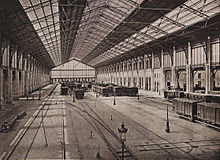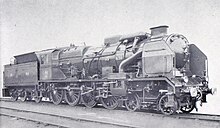Compagnie du chemin de fer de Paris à Orléans
The Compagnie du chemin de fer de Paris à Orléans ( PO ) was a French railway company organized under private law that existed from 1838 to 1934.
Geographical location


The PO network extended to Orléans and Tours in the Loire and Garonne area . From here branches led to Vendôme , Le Mans , the Atlantic coast via Angers , Nantes , St. Nazaire to Landerneau , south to Villefranche , Clermont-Ferrand and Toulouse , and southwest via Poitiers and Angoulême to Bordeaux .
history
Beginnings
The company was founded in 1838 in the legal form of a joint-stock company and had start-up capital of 40 million francs . The company received a 70-year concession to build and operate a railway line between the cities of Paris and Orléans . In the following years she implemented the concession. On May 2, 1843, the Paris – Orléans line was inaugurated. At 114 km it was the longest railway line in France at the time .

The starting point for the route was the Embarcadère d'Orléans station in Paris, which opened on May 2, 1843 and whose successor is now called Gare d'Orléans Gare d'Austerlitz .
In the early days of the railway, one of the worst railway accidents of the 19th century occurred when a train derailed and caught fire in 1842 after the axle of the steam locomotive broke . More than 50 people died.
Development up to the First World War

With government support, the PO took over several competing railways on March 27, 1852. These were:
- Compagnie du Center
- Compagnie du chemin de fer de Tours à Nantes
- Compagnie du chemin de fer d'Orléans à Bordeaux
- In 1853, the Compagnie du chemin de fer de Paris à Sceaux was taken over .
With these alliances, the PO had almost reached its final size. From 1852 to 1934 it was the second largest private railway in France after the Compagnie des chemins de fer de Paris à Lyon et à la Méditerranée (PLM). Its administrative headquarters were in Paris .
In 1892, the PO and the French state signed an agreement to operate economically unprofitable railway lines . The PO undertook to maintain operations there, and the state guaranteed the company's shareholders the minimum dividend in return .

On May 28, 1900, on the occasion of the world exhibition of that year , the Paris route was extended underground to the more centrally located new terminus Gare d'Orsay . After the PO had set up its first tunnel section, opened in 1895 between the Denfert-Rochereau and Luxembourg stations of the Ligne de Sceaux suburban railway , for operation with steam locomotives , electric locomotives were used in the new tunnel for the first time - and exclusively - . Power was supplied via busbars on the side ; the 550 V DC voltage used was later increased to 600 V. In 1903, under the direction of Hippolyte Parodi , electrical operation with power rails was expanded to the suburb of Juvisy-sur-Orge . In 1906 Parodi was appointed to be responsible for the electrical operation of the PO.

In accordance with the Freycinet plan , the PO also took on the construction and operation of branch lines in the province. Its subsidiary Chemin de fer du PO-Corrèze (POC) began operations on February 14, 1904 on the meter- gauge narrow - gauge railway from Tulle to Argentat .
| Nets 1912 | Route length |
|---|---|
| Main network | 5116 km |
| Lines with guaranteed dividends, standard gauge | 2351 km |
| Guaranteed dividend lines, narrow gauge | 323 km |
| Overall network | 7790 km |
Electrification and fusion with the midi
The extreme shortage of coal during the First World War - the most important coalfields were occupied by German troops - led in 1917 to the first considerations regarding the electrification of lines. The government sent a delegation of experts - including Hippolyte Parodi - to the United States , where they toured corresponding facilities on the Norfolk and Western Railway and the Chicago, Milwaukee, St. Paul and Pacific Railroad . After their return, on November 14, 1918, a committee was set up to determine the type of electrification of the various French networks. While the electrification of the northern and eastern French lines was rejected for strategic military reasons, it advocated the electrification of lines (approx. 8500 km) in the southern half of France and in the greater Paris area with 1500 V DC . To standardize electrification in the country, the use of this voltage was made mandatory on August 29, 1920. Against the background of this arrangement, the PO decided not to expand the 600 V power rail operation to Étampes .
In 1924, electrification began in the Juvisy-sur-Orge-Étampes section of the Paris-Bordeaux line . For the 2300 km projected by the PO - initially it was only about the most heavily loaded section of its network from Paris to Vierzon - a power supply of 1500 V via an overhead line was selected. Since the end section between Juvisy and Gare d'Orsay was already operated with busbars and the same voltage, electric suburban trains equipped with pantographs and sliding contacts on the side could run continuously from Gare d'Orsay to Étampes from 1927. In 1926 the electrically operated network was expanded south to Vierzon via Les Aubrais near Orléans , and in 1933 from Les Aubrais in a south-westerly direction to Saint-Pierre-des-Corps near Tours .
In 1929 the PO operated a route network of around 7500 km. The company started using railcars relatively early ; in 1929 it owned 93 of them. 1934 merged the PO and the Chemins de fer du Midi (Midi) et the Chemin de Fer de Paris à Orléans du Midi (PO-Midi). In 1935, the PO-Midi extended the electrification of the Les Aubrais-Orléans-Montauban-Ville-Bourbon line to Brive-la-Gaillarde and, in the south, to its continuation Montauban - Toulouse of the Bordeaux-Sète line . The electrical gap between Brive and Montauban was closed in 1943 under the direction of the Société nationale des chemins de fer français (SNCF).
The End
The new PO-Midi with a route network of almost 12,000 km replaced PLM as France's largest private railway until then. Four years later, the railway operation of the PO-Midi was nationalized on January 1, 1938 and taken over by the newly founded SNCF.
The PO-Midi was listed on the stock exchange . In particular, she was left with numerous properties . The French branch of the Rothschild banking family took over their majority after the Second World War and converted it into a holding company for their banking and corporate investments. Since September 2015 it has been operating under the name Rothschild & Co.
vehicles

1907 PO bought the first railway company in Europe "pacific" - steam locomotives for express services .
Although the PO was one of the pioneers of electric traction in the French railway network with the Midi, it was foreseeable that steam traction would continue for a long time. There were too many branch lines that would have been unprofitable to electrify, and diesel-powered locomotives had not yet become established. In 1925, she hired André Chapelon, one of the most capable engineers in steam locomotive construction. The developer of the Kylchap suction train system succeeded in significantly increasing the performance of steam locomotives through modifications. He first succeeded in doing this in 1929 with the 3566 locomotive of the "Pacific" class 3500; later rebuilt by him 242 A 1 of the SNCF is considered most powerful ever built steam locomotive in Europe.
"Pacific" locomotive 4546 of the PO in the Mulhouse railway museum "Cité du Train"
Remarks
- ↑ In the absence of a suitable name, the stations were initially referred to as "Embarcadère" (landing stage), analogous to shipping.
- ↑ Its name does not refer to a district or end point, but to the battle of Austerlitz in today's Czech Republic .
See also
literature
- The first train ride from Paris to Orléans . In: Illustrirte Zeitung . 4 Ed. = Johann Jacob Weber. J. J. Weber, Leipzig 1843, p. 52-54 ( Wikisource ).
- Victor von Röll: Encyclopedia of the Railway System. Volume 7. Keyword: Paris-Orleans-Bahn . Berlin / Vienna 1914, p. 468 f.
- Stefan Vockrodt: The Compagnie des Chemins de fer de Paris à Orléans. In: Railways in Paris (= Railway History Special. 2) 2015, ISBN 978-3-937189-94-9 , p. 36.
Web links
Individual evidence
- ^ NN: The first trip .
- ^ A b Victor von Röll: Encyclopedia of the Railway System.
- ↑ Didier Janssoone: L'Histoire des chemins de fer pour les nuls . Éditions First, Paris 2015, ISBN 978-2-7540-5928-2 , pp. 56 .
- ↑ a b c Ferrovissime No. 71 (September / October 2014), p. 32.
- ↑ Didier Janssoone: L'Histoire des chemins de fer pour les nuls , p. 67.
- ↑ Didier Janssoone: L'Histoire des chemins de fer pour les nuls , p. 52.
- ↑ a b c Didier Janssoone: L'Histoire des chemins de fer pour les nuls , p. 64 ff.
- ↑ a b c Stefan Vockrodt: The Compagnie des Chemins de fer de Paris à Orléans.
- ↑ Chapelon, André ( 1892-1978 ) at dmg-lib.org, accessed April 9, 2020
- ↑ J. Michael Mehltretter: Full steam ahead. Power and technology of steam locomotives . 1st edition. Transpress, Stuttgart 2013, ISBN 978-3-613-71469-4 , p. 69 .




